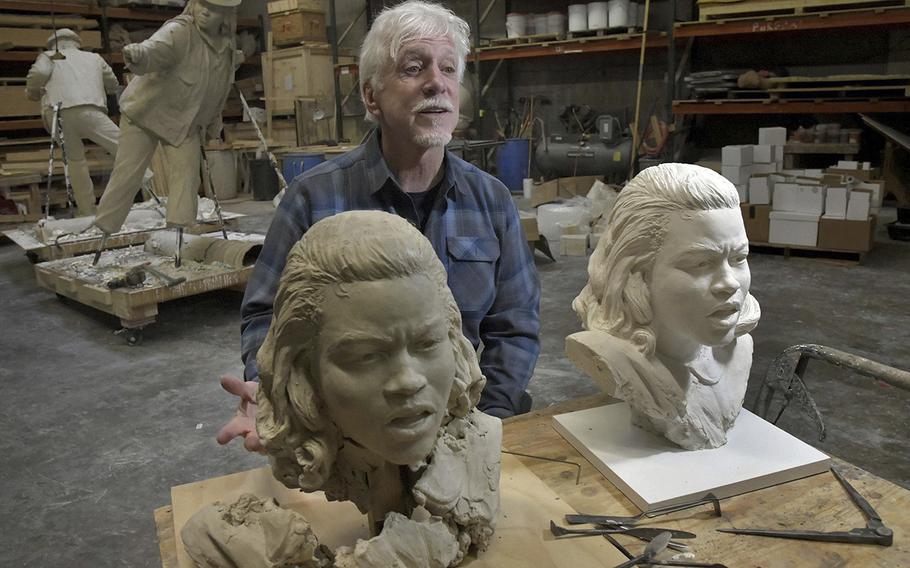
Sculptor Steven Weitzman in his Brentwood, Maryland studio with two versions of the head of civil rights activist Barbara Rose Johns, which will eventually be made into a full figure, cast in bronze. (Amy Davis/The Baltimore Sun/TNS)
(Tribune News Service) — Steven Weitzman is going to bring a civil rights icon to life in the U.S. Capitol.
Weitzman, 70, has been a full-time artist since he was 19 and it’s the only job he’s ever known. The Montgomery County, Maryland, resident has produced sculptures at his Prince George’s County studio of other deceased, well-known Black leaders, such as four-time D.C. Mayor Marion Barry and abolitionist Frederick Douglass.
“It was preordained with me,” Weitzman said. “Going to school, [it was] me just waiting, waiting, waiting, going through the motions to grow up enough to get out of school so I can be an artist.”
The bronze Douglass statue stands in the U.S. Capitol Visitor Center’s Emancipation Hall, where it was installed in 2013. A decade later, Weitzman has been tapped to produce a statue of Barbara Rose Johns, who as a 16-year-old girl played a pivotal role in the downfall of segregated schooling, for the Commission For Historical Statues in the United States Capitol. Johns died in 1991.
Johns’ image will replace Robert E. Lee, who stood in Statuary Hall until 2020 as the representative of Virginia; the state is also represented by George Washington. Three years prior, in Baltimore, former Mayor Catherine Pugh had four Confederate-linked monuments removed in the middle of the night on the heels of the fatal white supremacist march in Charlottesville, Virginia. One of the statues featured Lee and his fellow Confederate Gen. Thomas “Stonewall” Jackson.
Johns attended the segregated Robert Russa Moton High School in Farmville, Virginia, which later became a museum. According to the Robert Russa Moton Museum, Johns led her classmates on a strike on April 23, 1951, to protest the school’s “poor facilities, shabby equipment and no science laboratories or separate gymnasium.” She was ahead of her time.
“A lot of the pivotal moments in the civil rights movement had yet to take place,” said Cameron Patterson, the museum’s executive director. “Barbara Johns and her classmates played an incredible role in such a pivotal moment in American history.”
The students worked with lawyers Spottswood William Robinson III and Oliver Hill, who filed a lawsuit in federal court: Davis v. County School Board of Prince Edward County. That case was one of the five the U.S. Supreme Court reviewed in delivering the Brown v. Board of Education decision that ruled segregation unconstitutional. It was the only case spurred by a student movement, Patterson said.
Weitzman said his statue aims to capture the moment the mild-mannered Johns called upon 450 of her classmates to walk out. One of her hands will be balled in a fist, the other holding a book above her head, as she prepares to become one of the catalysts for desegregation in America.
While Weitzman came up with the sculpture’s design, Johns was chosen by the Commission For Historical Statues in the United States Capitol.
Julie Langan is the director of the Virginia Department of Historic Resources, which supports the commission. She said the commission received hundreds of nominations that produced 83 different subject suggestions from which Johns was chosen.
The commission unanimously chose Weitzman to produce Johns’ statue from among 10 detailed proposals, Langan said.
“From the beginning, we heard people voice the desire that we hire a Virginia artist and that we hire an African American artist, but that was never going to override our commitment to finding the most highly skilled sculptor for this commission. So we weren’t bound by those qualifications,” Langan said. “His presentation just really resonated with the commission.”
Weitzman, who said producing the sculpture is an “unbelievable honor,” said being white does not keep him from being sensitive to the history of the treatment of Black people and other minorities in America.
Weitzman has produced art of Black wood carver Elijah Pierce, Chief Niwot of the Southern Arapaho tribe and civil rights icon Rosa Parks.
“I see the world in full color,” Weitzman said. “I get the cultural differences of everybody. But I don’t see those cultural differences as a detriment. I see those cultural differences as a benefit for all of us because we’re one diverse group of people together.”
Weitzman has few photographs of Johns as a teenager to use as a reference. He invited Johns’ siblings to come to his Brentwood studio and guide his clay molding of Johns’ face.
“We’ll just sit and talk. We’ll have pictures, videos, whatever we have around us. I’ll have the little clay portrait of her and I’ll just start to sculpt,” Weitzman said. “And in the end, hopefully it’ll all resolve into the Barbara Johns that they know.”
Johns’ family could not be reached for comment.
The Virginia General Assembly has allocated $500,000 for the Johns project, including the costs of removing Lee and unveiling the new statue, Langan said. The sculpture will be completed between the end of 2023 and mid-2024, Weitzman said.
“There are many school-aged children that tour the Capitol on a daily basis and to be able to look up at a statue of a young person who did what she did at such a young age, 16 years of age, I hope that that speaks to those that walk through the Capitol doors,” Patterson said. “It’s a great example that big or small, your contributions towards improving your community can be really impactful and really important.”
©2023 The Baltimore Sun.
Visit at baltimoresun.com.
Distributed by Tribune Content Agency, LLC.